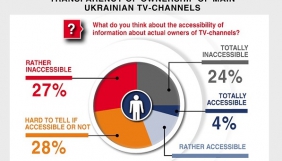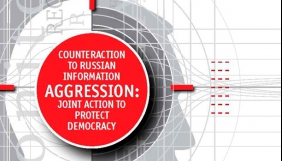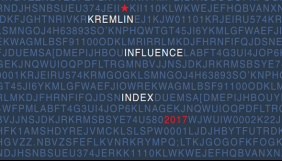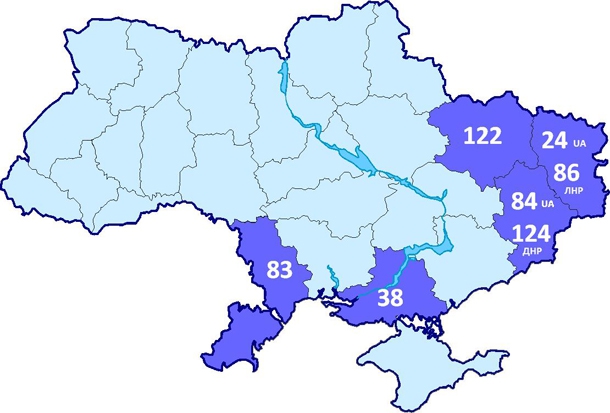
The Level of Russian Propaganda Messages Support in the Conflict Zone: Public Opinion Survey
The Level of Russian Propaganda Messages Support in the Conflict Zone: Public Opinion Survey
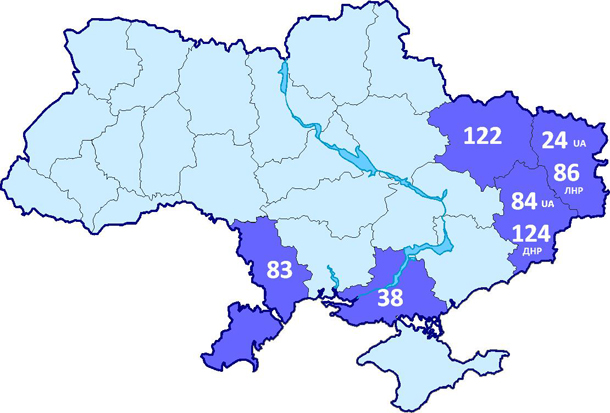

From February 26 to February 28, 2015, Kyiv International Institute of Sociology was conducting a survey «Counteraction to Russian Propaganda in the Conflict Region» by the order of NGO Telekritika. The study has embraced the urban population of five oblasts: Kharkiv, Odesa, Kherson, Donetsk, and Luhansk (including the regions being at entry out of the Ukrainian control).
According to the study, the main source of information on the situation in Ukraine for the inhabitants of the south-eastern regions is television: 83% of the respondents receive news from the national TV channels. About one third of the respondents state that they can receive Russian TV channel “RTR”; Russian TV channels “NTV” and “ORT” have the same indexes; 17% of the respondents receive “RBK.”
The most demanded information in the ATO zone is the data about those who disappeared, losses among civilian population and Ukrainian soldiers, local and state power actions.
The citizens of the territories under Ukrainian control are likely to believe Ukrainian sources and consider Russian media to be biased and nonobjective. The opposite views are spread in the People’s Republic of Donetsk and People’s Republic of Luhansk. Still, all the inhabitants of the south-eastern oblasts gradually experience escalating disillusionment with any media.
Russian propaganda is steadily winning at the occupied territories. Other south-eastern regions demonstrate no support for the messages of Russian propaganda. The least popular are the messages like “Maidan is a fascist revolution.” The latter is supported by only 27% and not supported by 54%. The assessment of the Maidan outcomes is rather pessimistic. The overwhelming majority (66%) think that the main consequences of Maidan are the annexation of the Crimea, the war conflict in Donbas and the economic breakdown in Ukraine. The opponents make up only 15%.
Despite the disillusionment with the Ukrainian power, the ideas of separatism at the territories under Ukrainian control have not taken root. 84% consider that Donbas should remain a part of the Ukrainian state. As for “people’s republics,” 50% would like to separate, while another 50% are likely to scrutinize the opportunity to remain within Ukraine provided that the status of the territory is changed.
Analytical report on the study “Counteraction to Russian Propaganda in the Conflict Region”
From February 26 to February 28, 2015, Kyiv International Institute of Sociology was conducting a survey «Counteraction to Russian Propaganda in the Conflict Region» by the order of NGO Telekritika. The sample of the survey is representative for adult urban population of five oblasts: Kharkiv, Odesa, Kherson, Donetsk, and Luhansk (including the regions being at entry out of the Ukrainian control). All in all, there were 561 interviews conducted in 124 communities by the CATI method (computer-assisted telephone interviewing).
The representation sample is stratified according to oblast and community type (regional centre, cities with population over 100,000 inhabitants, cities with population from 20,000 to 99,000 inhabitants, towns with population less than 20,000 inhabitants). Besides, Donetsk and Luhansk oblasts were divided into the territory under the Ukrainian control and the territory controlled by «People’s Republic of Donetsk» (PRD) or «People’s Republic of Luhansk» (PRL). Several random telephone numbers were selected from the database within each stratum. A quota selection of respondents by gender and age was applied at the last phase of the survey. The influence of inner migration from the ATO zone on the actual number of population in each oblast was calculated according to the public information of the UN Refugee Agency. The survey has taken to account the UN Refugee Agency information on the percentage of inner migrants in other oblasts and the results of the previous KIIS studies intended to find out the amounts and direction of migration from «People’s Republic of Donetsk,» «People’s Republic of Luhansk» and front line territories of Donetsk and Luhansk oblasts. Therefore, the ratio of respondents from PRD and PRL has been reduced from 37% to 27%.

The sources of news on the latest events in the country
Television, Internet and personal relations are the key information channels for the audience
The main source of information on the situation in Ukraine for the inhabitants of the south-eastern oblasts is television: 83% of respondents receive news from the national channels. The second place is taken by online media: 41% of respondents read web resources. The third place is taken by personal relations: 24% of respondents receive information from relatives, friends, and neighbours. Next positions are taken by national newspapers (22%), social networks (17%), large radio stations (16%), and acquaintances from the ATO zone (10%).
The level of credibility to different information sources among all the inhabitants of the region is the following: national television (50%), online media (26%), personal relations (26%), and witnesses from the ATO zone (12%).
The level of credibility is also calculated by the percentage of the users who consider the source of information to be trustworthy. According to the survey, the most trustworthy are the evidences of those who have been in the ATO zone; the next position of trust is shared by the news of national TV channels, online media, and entourage.

The channels with the largest coverage area in the conflict region are “Inter” and 1+1; they are followed by First National, STB, “Ukraine,” ICTV, “Novyi,” and 5 Channel. About one third of the respondents admit receiving Russian channels “RTR,” “NTV,” and “ORT”; 17% of the respondents receive “RBK.”
The coverage area of the channels is expectedly different at the territory occupied by the terrorists and the one controlled by Ukraine. “RTR,” “NTV” and “ORT” is available to every second person in “people’s republics”, while outside the republics they are available to every fifth person. In turn, the coverage area of the top five Ukrainian channels[1] in PRD and PRL makes up from 40 to 50%, whereas at the rest of the territory it makes up from 77 to 90%. It is worthy to note that each channel is analyzed separately.

In total, 63% of the the population of «people’s republics» can receive at least one of the four Russian TV channels listed above; 61% of them can receive at least one of the Ukrainian channels. As for the population of the rest of the sample territories, 28% have access to at least one of the Russian TV channels, and 91% have access to the Ukrainian channels (7% do not watch TV at all). Hereby, despite the legislative prohibition, Russian channels are still available for a good deal of the Ukrainian citizens.
The leader of TV news for the audience of the south-eastern oblasts is “Inter,” followed by 1+1. During the previous two days, 42% and 36% of the respondents admit having watched the news at “Inter” or 1+1, respectively. 21% of the respondents were watching news at “Ukraine,” and 12% were watching the news at 5 Channel.
During the previous two days, the news at “RTR,” “NTV,” and “ORT” was watched by 8%, 5% and 10% of the respondents, respectively.
During the period, the news at Russian channels was watched by 46% of the population of “people’s republics” and only by 8% at the rest of the conflict region.

Russian TV channels are mostly available via satellite aerial and cable television (42% and 38%, respectively). 6% of those who watch Russian TV channels do it via the web.

70% of all the respondents use the Internet. 52% read online media sometimes and 47% log in social networks (which does not contradict with lower indices concerning the answer on the main information sources for the respondents).
The most popular web resource is the UKR.NET portal: 19% of the respondents were using it during the previous two days. The next are “Korrespondent.net” (17%), “Censor” (10%), and “Obozrevatel” (10%).

The most popular social network to share the news is Vkontakte (25%), followed by Odnoklassniki (22%) and Facebook (21%).

The most famous Russian journalist is Dmitriy Kiseliov. 28% of the respondents watched his statement during the previous month. However, the level of credibility to Kiseliov as to a famous media personage is rather low: 8% of the respondents believe him to be objective and unbiased. The second place is taken by Vladimir Pozner whose statements were watched by 18% of the respondents. Pozner has the highest level of credibility among all the Russian journalists and analytics mentioned in the survey (11%). The third place is taken by Aleksandr Gordon (14% of watchers and 8% of credibility).
48% of those who know at least one Russian journalist believe no one of them to be objective and unbiased.

During the previous month, the most popular with the respondents was the statement of the Ukrainian journalist Yevgen Kyseliov (21%). The second place is taken by Oles Buzina (15%); the third place is taken by Andriy Kulikov (12%). Knowing at least one of the journalists, the respondents believe the same media personages to be objective: Kyseliov (14%), Buzina (15%), and Kulikov (6%). One more person with rather high level of credibility is Matviy Ganapolsky: although his statement during the previous month was seen by 7% only, 5% of the respondents believe him to be unbiased.
35% of the respondents find all the journalists listed above biased.

The objectivity assessment of the Ukrainian and Russian sources of information
Among the population of the south-eastern oblasts, the amount of those who trust the Ukrainian TV channels (national, local, and public) and the amount of those who don’t are almost equal. Such a correlation is the same for the users of Russian social networks. Russian TV channels lack credibility: the amount of those who find them to be objective is significantly lower than of those who don’t.

The objectivity assessment demonstrates essential differences between the territories under Ukrainian control and out of it. The territories under Ukrainian control believe the Ukrainian sources to be rather truthful (although a good deal of respondents doubt of it) and Russian sources to be biased and preconceived. In PRD and PRL, the opinion is just opposite.

With time, the inhabitants of the south-eastern oblasts experience escalating disillusionment with any media. 29% of the respondents have experienced disillusionment with the Ukrainian media, and 37% of the respondents have experienced the disillusionment with the Russian media. The trend seems to be a kind of manifestation of the overall disillusionment and pessimism, since the data given below prove that watching either Russian or Ukrainian TV channels hasn’t changed for the previous six months.

20% of the interrogated TV viewers admit having increased watching the Ukrainian TV channels, while 17% admit having reduced it. 9% tend not to watch Ukrainian TV channels at all.
12% of the respondents consider watching Russian TV channel more than six months before, while 15% consider watching less. 46% tend not to watch Russian TV channels at all.

In total, Russian media are steadily winning the battle for the conscience of the occupied territories’ population. In turn, they have poor reputation at the territory under Ukrainian control. However, it doesn’t mean that people turn to believe the Ukrainian media: a good deal of people is not certain of their objectivity and impartiality.
Information on the ATO zone withheld by media
The most demanded information is the data about those who disappeared, losses among civilian population and Ukrainian soldiers, local and state power actions. Information on the means of survival is less topical. About every fifth citizen does not believe the information from the ATO zone delivered by media.
The respondents were offered to identify what information from the ATO zone is not reported enough by the Ukrainian media. There was no option “Enough information”; the interviewer himself fixed such an answer or the situation in which information was “sufficient, but not objective”.
In general, people most of all lack information on their nearest and dearest who could perish or be reported missing. 28% of the respondents consider there should be more information on missing people and victims among civilian population. 26% consider there is not enough information on the perished military men.
The least demanded information is about electricity supply to the ATO zone and dislocation of the troops.
22% of the respondents consider there is enough information; 17% of the respondents spontaneously admit that there is enough information, but it does not correspond to reality.

The attitude to censorship and propaganda
Despite the threat existing in the information space, the citizens of the conflict zone have no specific attitude to the necessity or admissibility of Ukrainian propaganda and are rather against censorship.
42% of the respondents agree that under current circumstances the journalists should be allowed to make propaganda reports for the benefit of the Ukrainian state. 41% of the respondents disagree with this statement. 35% of the respondents of the territories under Ukrainian control disapprove propaganda (48% approve), while in “people’s republics” 57% disapprove and 25% approve.
The majority of the respondents (59%) would allow journalists to criticize the Ukrainian army; 29% are against. The support of criticism is gradually growing. Perhaps, the rate of those who are against censorship is even higher than in PRD and PRL (60% against 54%). Perhaps, the citizens of Ukraine mean criticism of the Ukrainian officers, mobilization campaign or army supply, while the citizens of the occupied territories demand investigation of military crimes and abuse.
The amount of those who support turning the First National into a propaganda channel is 35%. 45% of the respondents are against. 38% of the respondents approve special propaganda channels. The same amount disapproves it. The amount of critics of the Ukrainian propaganda is expectedly higher in PRD and PRL.

All in all, there is no definite belief in the conflict zone that Russian propaganda should be counteracted by Ukrainian one. The very term of “propaganda” has negative associations with deceit and disinformation, so that may be a reason. Many people believe that the war is not a reason for media to infringe the principle of information objectivity.

The interpretation of the events in Ukraine: the support of Russian propaganda messages
Russian propaganda is steadily gaining victory in the occupied Donbas. Other south-eastern regions do not support the provocative messages of Russian propaganda. However, there is a significant portion of the audience who are potentially receptive to the information that increases domestic instability.
Further, the respondents were asked whether and how far they share different ideas of the events in Ukraine. Some of the statements are typical for Russian propaganda; others are spread by Ukrainian media.
One of the clear markers of pro-Russian or pro-Ukrainian position is the attitude of the respondents to the protests of winter 2013-2014 at Maidan. In particular, there is the interpretation of the events either as a fascist revolution or as people’s protest; either caused by higher manipulations or by public discontent; the assessment of the main consequences of the events as well.
It is important to note that most of the statements are not mutually exclusive: a respondent could agree with several interpretations of the same phenomenon.
The least popular statement is that Maidan was a fascist revolution. It is supported by 27% and not supported by 54% of the respondents. Instead, 61% of the respondents are sure that Maidan was a people’s revolution (24% do not support this statement).
The reasons of the events are interpreted less definitely. 54% of the respondents consider that Maidan was conditioned by Yanukovych’s refusal of European integration. 51% are sure that the protest was provoked by oligarchs and the USA (some of the respondents supported both versions). 23% do not support the version of “people’s discontent,” while 18% do not support the “conspiracy” version.

The support of the messages delivered by Russian media is much higher in PRD and PRL than on the rest of the zone. 49% consider Maidan to be a fascist revolution; 67% believe it was conditioned by oligarchic conspiracy and U.S. manipulations (at the territories under Ukrainian control the rates are 19% and 46%, respectively). Still, 41% are ready to admit it was a people’s revolution; 47% consider the refusal of European integration to be one of the reasons of Maidan (68% and 58% for the territories under Ukrainian control).

The consequences of Maidan are assessed rather pessimistically. The overwhelming majority (66%) think that the main consequences of Maidan are the annexation of the Crimea, war conflict in Donbas and the economic breakdown in Ukraine. Only 15% disagree with the statement. 48% of the respondents support the idea that Maidan has resulted in public protest of Donbas citizens for the region’s rights enlargement. Only 24% hope that the protests of winter 2013-2014 have increased Ukraine’s chances for European integration and economic development.

Assessing the main consequences of Maidan, the inhabitants of PRD, PRL and the rest of the territory are almost solid, the only thing that the first are more likely to agree civil protest in Donbas for extended rights was the main consequence and disagree that Ukraine has now more perspectives for economic development and entering into the EU.

One more marker item to identify pro-Russian or pro-Ukrainian position is the assessment of the Ukrainian power actions in Donbas either as a war with Russia and terrorists or as a civil war against the Ukrainian people. 51% of the respondents consider the war conflict in Donbas to be a war with Russia (26% are against); 46% consider it to be a war against terrorists (31% disagree). 40% agree with the key message of Russian media, according to which the war is against the Ukrainian people (44% disagree).

No opinion concerning war conflict in Donbas is dominating because the sample includes the opposite sides of the conflict with fundamentally different positions. 71% of the inhabitants of the occupied territories believe it to be a civil war; 20% believe it to be a war against terrorists; 30% believe it to be a war with Russia. The inhabitants of Ukrainian regions qualify the conflict as a war with Russia (59%). Those who see it as a war against the Ukrainian people are relatively few (28%).

21% of the respondents believe that ATO is implemented by mercenaries from the USA and Europe. In PRD and PRL the amount is twice higher: 36% against 15. 48% of the respondents believe in the participation of Russian servicemen under Russian command on the terrorists’ side (27% in PRD and PRL; 56% of the rest). About one third of the respondents have no definite opinion on the matter.

No matter who is fighting on the terrorists’ or the ATO side, the respondents are sure that both sides are bearing major casualties during the conflict. People on both free and occupied territories agree in this question, despite all the efforts of two-way propaganda that tries to overestimate the enemy’s casualties and underestimate their own.

However, the statement that on both sides of the front line there is a severe persecution of the people who speak another language or who are differently minded is not so popular among the respondents. 25% of the respondents agree that the Ukrainian language and Ukrainian patriotism are persecuted in PRD and PRL (38% disagree). Among the inhabitants of the occupied territories, 14% support the idea; as for the Ukrainian territory, the supporters are 30%. The statement that ethnic Russians and Russian language are persecuted in Ukraine is supported by only 17% (32% in “people’s republics”; 12% out of them). In this way, about one third of the residents taking part in the survey consider that the opposite side is engaged in persecution of either Ukrainian or Russian civilians.

In total, the Ukrainian media are apparently losing to Russian media at the occupied territories. In the south-eastern regions under Ukrainian control, the support of the most controversial and disturbing Russian propaganda messages (e.g. about fascist revolution or Russian language persecution) is rather weak. Still, a good deal of people pessimistically assess the Maidan consequences, being aware of great casualties of the Ukrainian army and having controversial opinion about the war conflict in Donbas. There is a serious risk that the worse the situation in the state, the more defeating Russian messages will be against pro-Ukrainian ones.
The assessment dynamics of the participants of the conflict in Donbas
The majority of the respondents assess the actions of both sides of the conflict as unfavorable for well-being of the Ukrainians. 46% do not believe in good intentions of either of the powers.
The respondents were asked how far they agree that the Ukrainian and Russian power, the EU and the U.S. government are acting for the benefit of the Ukrainian people (taking to account their own well-being as well). The answers, in which the governors of other countries were believed to care only about their own citizens, were assessed as disagreement with the statement.
66% of the respondents consider that the Ukrainian power is acting against the interests of the Ukrainian people. Russian government has almost the same index (69% of unbelievers). The efforts of the EU and the USA intended to regulate the situation in Donbas are not supported by the inhabitants of the south-eastern oblasts either. 68% of the respondents consider that the actions of the EU government are not directed at well-being of the Ukrainian citizens. 73% keep to the same mind about the States. Diplomatic support, sanctions, and credits do not convince the people of good intentions of the West.

The attitude of the population of the south-eastern oblasts to the leaders of the states engaged in the conflict is getting worse with time. People are becoming more and more disappointed in the Ukrainian power.
In another question the respondents were asked how their attitude to the combatants and the leaders of the countries influencing the conflict in Donbas has changed during the previous six months. The answers prove the previous conclusions.
The main cause of public disillusionment is the Ukrainian power: 64% of the respondents state their attitude has worsened since autumn 2014. The attitude to the leaders of other countries has changed to worse as well: the leaders of Russia (49%), the leaders of the EU (43%) and the leaders of the USA (45%). Such a tendency is the same for the Ukrainian territories and those under terrorists’ control. The only thing is that almost equal amount of people in PRD and PRL has changed the attitude to Russian power to worse and to better, while under Ukraine the attitude has changed to worse only.
In total, the inhabitants of the entire region begin to disbelieve those who should have mitigated the conflict and stop fighting. Instead, the problems are escalating; war conflict seems to have no ending, while the hopes for diplomatic solution turn to be in vain each time. The first and foremost responsibility, in people’s view irrespectively of their political believes, is on the Ukrainian government.

The support of the combatants is growing in the regions under their control
As for the very participants of fighting in the East, the attitude to the Ukrainian army and volunteer battalions has improved at the territories under Ukrainian control and worsened in PRD and PRL; and contrariwise for the fighters of “people’s republics.” 27% of the PRD and PRL respondents have improved their attitude to illegal gangster formations, 15% have worsened it (1.8 to 1). This compares to 33% of the Ukrainian respondents who have improved their attitude to the army and volunteers and 12% who have worsened it (2.8 to 1). As opposed to power, the army is accepted as a real force that gives protection.

The optimal solution for the situation in Donbas
According to the opinion of the inhabitants of the south-eastern oblasts, Donbas should stay a part of Ukraine.
Despite total disillusionment and mistrust to the Ukrainian power, the majority of the respondents do not see Donbas out of Ukraine. One third of the respondents (33%) want the territories of PRD and PRL to return under Ukrainian control under the same rights as before. Another third (31%) consider that Donbas should be given extended power, while 10% wish the region to become an autonomous republic within federative Ukraine. 11% are for the region’s independence, and 7% would like to see it as a part of Russia.

Even at the territories uncontrolled by Ukraine a half of the respondents think that the optimal scenario is Donbas staying within Ukraine (better under the terms of decentralization or federalization). Still, each fourth respondent would choose independence for his or her region, and 16% would join Russia. This compares to 76% of the respondents at the territory under Ukrainian control who want to return Donbas to Ukraine under the same terms or decentralization; 8% are for federalization and only 9% want the region to be separated or joined to Russia.
In this way, the ideas of separatism at the territories under Ukrainian control have no success among their target audience. Most of the people support one of the decisions associated with the maintenance of state structure. The ideas of federalization and constitutional reform promoted by Russian Federation at the diplomatic level haven’t taken root in the society. At the territories uncontrolled by Ukraine the situation is worse, but even there each second respondent is not against returning to Ukraine under the new terms of social agreement and additional power for the region. The expectations for entering into Russia are not many, but the wish to separate is strong.
Perceptions of the Ukrainians and the Russians
The military actions in Donbas are not only a military threat. The society under war is radicalized; international relations are ruined; the rhetoric of humiliation and dehumanization escalates. It is especially painful in the societies like Ukrainian one, in which there is a large Russian minority and many people have close relationships with Russia. Hostility to another nationality or ethnic group is inevitable under war conflict; it helps the nation to consolidate against common enemy, but damages mutual understanding within the country as well.
In order to find out in what way the events in Ukraine have influenced the attitude to other nationalities, the respondents were asked what character features are associated with this or that nation: “Some people consider that each nation has its peculiar features of character. I will read a list of human qualities. In your opinion, what qualities are typical for the Russians?” and “In your opinion, what features are typical for the Ukrainians?” Being translated into Russian, the language used in most of the interviews, the term “Russians” sounded like “rossiiane,” not “russkiie,” in order to underline that the question is about the citizens of Russia, not the representatives of the ethnic group. There were 17 qualities in the list; half of them were rather positive, another half was rather negative.
In addition, the respondents were asked about their national self-identification. According to the answers, there were 2 groups: those who identify themselves as the Ukrainians and those who identify themselves as the Russians (“russkiie”). The assumption was that “russkiie” are likely to associate themselves with the Russians (the citizens of Russia), but not to a full extent, because there is a good deal of ethnic Russians who support the Ukrainian national idea. The Ukrainians apparently associate themselves with the citizens of Ukraine. The more one of the ethnic groups chooses positive features for themselves and negative for another ethnic group and the more the gap between the portraits of the Russian and the Ukrainians in each of the communities, the stronger the international hostility is revealed.

Both the Ukrainians and the Russians (by ethnic self-identification) are likely to characterize “their own” national group in a positive way. The Ukrainians consider themselves to be peaceful (68%), helpful (65%), open-hearted and homely (58%). The Russian respondents consider the Russians to be first of all helpful (69%), then open-hearted and homely (49%) and peaceful (47%).
Each ethnic community characterizes another national group less favourably than their own, but the balance of positive and negative characteristics is the same: the representatives of one group admit that another group has positive features, not only negative ones. For Ukrainian people, the Russians are first of all helpful (35%), open-hearted and homely (30%), hospitable and obtruding their own customs to others (27% each). For Russian people, the Ukrainians are helpful and peaceful (30% each), hypocritical and sly (28%) and hospitable (27%). It is important to note that there are no specific features to characterize the representatives of another ethnic group; the portrait is vague.
It is interesting to compare the results of the survey with the results of the Russian Levada-Centre which surveyed the Russians on characterizing themselves as well as the Ukrainians[2]. The attitude of the citizens of Russia to the Ukrainians is much worse than the Ukrainians’ attitude to the Russians.
The data in the tables below were taken from two studies: the data on the attitude of the Russians from Russia to themselves and to others were taken from the survey of Levada-Centre; the data on the attitude of the Ukrainians and Russians from Ukraine to themselves and to others were taken from this survey (it is important to remind that the data on Ukraine can be generalized only for the urban adult population of 5 oblasts).

The study was conducted within the project implemented by NGO Telekritika under financial support of the Internews Network.



